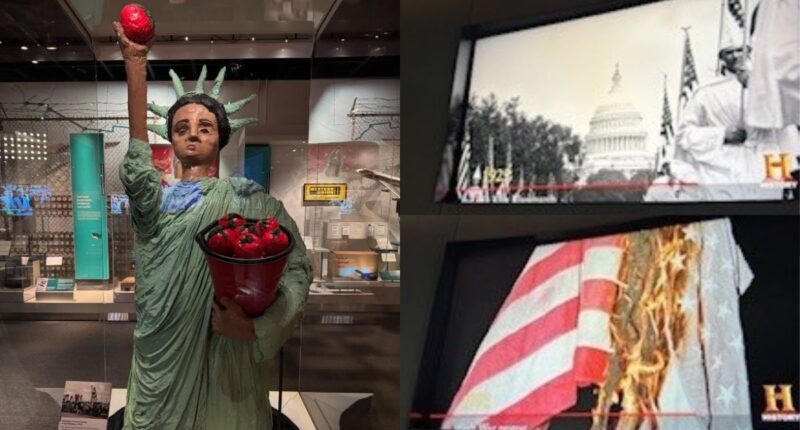The Smithsonian Institution is one of America’s greatest assets.
When Americans visit the nation’s capital in Washington, D.C., they are able to witness their country’s vast array of art, culture, history, and research acumen all in one place, and for free, because of the museums and zoo the institution operates there.
Like the national parks, the Smithsonian is part of America’s cultural inheritance.
But because of its academic and historical nature, the institution, established by an act of Congress that was signed by President James K. Polk in 1846, has always been in a precarious situation where dishonest and destructive actors who have deep disdain for the United States might take over its stewardship.
That appears to be what has happened, particularly under the Biden administration, as museum halls are adorned with gay “pride” flags and exhibits are filled with pseudo-history or history that is framed dishonestly — seemingly in an attempt to degrade the American experience.
That is a far cry from the Smithsonian Institution’s mission: to be “an establishment for the increase and diffusion of knowledge among men,” as initial patron James Smithson (after whom the institution is named) said in 1826 when willing his estate ultimately to the United States. Smithson’s donation would over time become the world’s “largest museum, research, and education complex,” boasting 21 museums, a zoo and conservation biology institute, and nine research facilities.
To that end, Trump administration officials — including Lindsey Halligan, Special Assistant to the President and Senior Associate Staff Secretary, Domestic Policy Council Director Vince Haley, and Office of Management and Budget director Russell Vought — wrote a Tuesday letter to Smithsonian Secretary Lonnie G. Bunch III initiating an internal review of the Smithsonian’s exhibitions and materials.
“It is an honor to work alongside the Smithsonian in reviewing its museums and exhibits, with the shared goal of ensuring this treasured institution reflects the very best America has to offer — accuracy, excellence, and the richness of our shared history. While certain ideological influences have permeated the Smithsonian over time, our goal is for the Smithsonian to be fact-based, scholarly, and historically sound,” Halligan told The Federalist. “The current Smithsonian exhibits are publicly available so everyone can see firsthand what we have observed. We invite the public to form their own judgments and better understand why we believe certain changes are necessary to preserve the integrity of our shared heritage.”
Admission is free to everyone, Smithsonian buildings line the National Mall from the Capitol Building to the Washington Monument, and since 1970 they have been visited by between 20 and 30 million people per year, save for some off years.
While two of the notable off years included 2020 and 2021 — when there were protocols related to the coronavirus and the museums only saw three million to five million visitors — visitation has not returned to pre-coronavirus levels, with last year seeing fewer than 17 million visitors.
The phenomenon raises concerns about the broader left-wing project to force Americans to hate their history and their country. Corrosive outgrowths of that project have been seen, perhaps most acutely, at the Smithsonian museums in recent years, and the woke-scolding nature of their exhibits may be an explanation for their dwindling numbers over the course of the Biden administration’s tenure.
The Trump administration’s review will be all-encompassing and phased, starting with eight museums first: American History, Natural History, African American History and Culture, American Indian, Air and Space, National Portrait Gallery, and the Hirshhorn Museum and Sculpture Garden.
All aspects of each museum’s process will be reviewed, including public-facing content, the curation process, planning of exhibitions, how collections are used, and standards for narrative building.
Such a broad review appears to be necessary, as tourists and visitors to the museums in D.C. have offered images and insight to The Federalist detailing the countless examples of the far-left ideological capture of one of our nation’s greatest resources.
Information obtained by The Federalist shows that the Trump administration’s concerns are not unfounded.
Promoting Homosexuality and Maligning the American Flag
As the Trump administration works to restore a semblance of reality and prestige to the Smithsonian museums, it makes sense to start a review with the museum dedicated to American history.
At the American History Museum, which is located in the shadow of the Washington Monument, Americans who want to learn about their history must first be bombarded at the front entrance with a “pride-progress” flag.

A ‘pride-progress’ flag greets American History Museum visitors at its Constitution Avenue entrance
Image CreditCourtesy of Tourists and Visitors of the Smithsonian museums
True to form, one of the exhibits argues in favor of “transgender” athletes competing in sports against members of the opposite sex. It questions why anyone would think it necessary to test the sex of athletes before a competition, denying the advantage men have over women because of testosterone and other biological realities like bone density and muscle mass.
“Proponents believe that gender testing prevents transgender athletes and athletes with high testosterone levels from gaining an unfair competitive advantage,” it states. “However, critics argue that gender tests are humiliating and discriminate against athletes who challenge traditional gender norms.”
While visitors are greeted with the LGBT flag at the door, the exhibit about the U.S. flag — the Star-Spangled Banner exhibit — advances left-wing causes as well. On separate slides it shows the flag being used at an “immigrant rights rally” or with LGBT material. Other slides show the flag burning, being used at a Ku Klux Klan rally, or alongside anti-American propaganda.
‘America Is Evil’ and Also Needs Mass Illegal Immigration
Visitors can also get a preview of the future addition to the Smithsonian network, the National Museum of the American Latino, which is still in its planning stages but will ultimately be situated alongside the others on the National Mall.
“¡Presente! A Latino History of the United States” will be the first exhibit of that museum, yet those interested can look at it now in the American History Museum — but only if they want to be hit with anti-America propaganda.
At the outset, visitors are told to “reflect on the effects of colonization and slavery in the Americas and throughout the world,” which frames the entire exhibit as one where the United States is an evil force for destabilization and imperialism, and Latinos have been bearing the brunt of that burden for all time.

‘!Presente! A Latino History of the United States’
Image CreditCourtesy of Tourists and Visitors of the Smithsonian museums
As writers at The Heritage Foundation put it three years ago, the exhibit is a “hothouse to curate grievances against the United States.”
“The Latino exhibit simply erases the existence of the Hispanic who loves, contributes to, benefits from and exemplifies the promise of American liberty,” they stated. “That is to say, it erases the Hispanic majority.”
The exhibit suggests that the United States stole one-third of Mexico’s landmass in 1848 with the Treaty of Guadalupe Hidalgo, which recognized the Rio Grande River as the southern border of the U.S. and finalized Texas’ becoming part of the United States.

Stand-alone quote from the American History Museum
Image CreditCourtesy of Tourists and Visitors of the Smithsonian museums
A 2021 quote from artist-activist Judy Baca on a pillar in the exhibit states, “We didn’t cross the border; the border crossed us.”
The Texas Revolution, according to the exhibit, was actually a massive defense of slavery waged by “white Anglo Saxon” settlers against anti-slavery Mexicans fighting for freedom, not a Texan war of independence from Mexico.
It also pushes the idea that Cuban immigration had nothing to do with escaping Cuban dictator Fidel Castro, but was rather a movement motivated by economic considerations.
The exhibit strains to connect other left-wing ideologies to the narrative, including leftist propaganda on labor, education, housing, immigration, justice reform, and “LGBT rights,” while discounting American sovereignty.
America has utilized Western capitalism to oppress minorities, the planet, and the Global South, according to the exhibit, which therefore concludes that all the “oppressed” intersectional groups that allegedly exist in Latin America have been fighting for “global justice” against a domineering United States.
To that end, the museum uniformly presents indigenous populations positively or as victims, without qualifications about violence, child sacrifice, or other behavior.
The exhibit remarkably leaves out mentions of the abuses of left-wing dictators like Fidel Castro of Cuba and Hugo Chavez of Venezuela, while making sure to show how the United States backed right-wing dictators like Fulgencio Batista of Cuba and Rafael Trujillo of the Dominican Republic.
Immigration is yet another area where each story told is aimed at advancing the open borders narrative, completely discounting national sovereignty and suggesting that controlled immigration is a human rights abuse.
To further that narrative, the exhibit depicts migrants looking at Independence Day fireworks “through an opening in the U.S.-Mexico border wall,” and a description to the side of it called “Fear and Prejudice” quickly maligns Benjamin Franklin and essentially all founding-era leaders as having “feared non-White immigration.”

‘Fear and Prejudice’ section
Image CreditCourtesy of Tourists and Visitors of the Smithsonian museums
“Instead of being recognized as community builders, Latin American immigrants are sometimes described as ‘invaders,’” it states. “Many have risked their lives to immigrate because they believe in U.S. ideals such as democracy, equality, and opportunity.”
It makes no mention of the violent gangs and individuals committing crimes against Americans, their drugs that kill countless American people, or their economic effect in taking jobs and upending the lives of American citizens.
‘Profound Unsettling of the Continent’
The founding of America, from the colonial era through the revolution, was not a historic triumph of liberty, the American History Museum insists, but rather a “profound unsettling of the continent.”
“The continent’s population actually declined in this period as Old World diseases swept through Native populations that lacked immunity. Beyond that profound tragedy there would be new conflicts, new forms of freedom, new forms of slavery, and new ways of living together,” the exhibit states. “Our world today grows out of that unsettling history.”
Explicit Attacks on Benjamin Franklin
A visitor to the American History Museum cannot get two sentences into an exhibit about the scientific works of Benjamin Franklin without being bombarded, at every single turn, with mentions of slavery.
In fact, there is a QR code near the exhibit on the Star-Spangled Banner telling visitors they can find out more about his “electrical experiments and the enslaved people of his household.”
In an apparent attempt to undermine Franklin’s contributions to the American founding and to science, the Smithsonian says that “Franklin’s remarkable scientific accomplishments were enabled by the social and economic system he worked within.”
“Franklin enslaved people, perhaps as many as seven. Their labor helped to build his fortune,” the exhibit states, while speculating and admitting there is no evidence that the slaves “may have directly assisted his research.”
If one were looking to find out more about Franklin’s research, it would be tough to do in this exhibit which appears to entrap people by promising his scientific history, but then quickly turns into a diatribe about slavery.
“Franklin’s involvement with slavery is complicated. He published anti-slavery articles in his newspaper while also profiting from the sale of enslaved people and printed notices seeking the capture of escapees,” the exhibit states. “Later in life he took an overt stand against slavery, becoming president of the Pennsylvania Society for the Abolition of Slavery in 1787, supporting gradual emancipation. But Franklin never emancipated any of the people he enslaved.”
Almost as if the writers suddenly remembered that this was supposed to be about scientific research, not slavery, the exhibit states, “Franklin’s place in the nation’s history of slavery is part of his legacy, as is his electrical research that led to the smartphone.”
The constant mentions of slavery continue, with a small amount of scientific discovery or inventions woven in.
This 1763 engraving is one of dozens that bolstered Franklin’s fame as a scientist. It shows two of Franklin’s inventions: alarm bells that alerted him when the atmosphere became charged with electricity, and a lightning rod.
Missing from the image are the people whose labor freed Franklin to conduct his research: the women, indentured servants, and enslaved people who maintained his household, assisted him, or made or operated equipment.
The narrative goes on, and on, and on — continuing to make accusations and then admitting there is no evidence for them.
Benjamin Franklin was not just a founding Father, but a scientist. From 1746 to 1752, he conducted experiments that changed peoples’ understanding of electricity. The sparks of his inventive mind drove research and led to new inventions.
Those sparks crackle with the complications of his time. Enslaved people helped build his fortune, and may have participated in his research. We still have much to learn about that part of his scientific work.
The Coronavirus ‘Racism’ Psy-Op
An exhibit in the lobby of the second floor, immediately next to one of the museum’s main entrances, shows a “stop Asian hate” protest during the coronavirus — the “Asian hate” being a psy-op invented by the corporate media to hide the fact that the coronavirus did, in fact, come from China.
“As COVID-19 spread across the United States in early 2020, San Francisco’s Chinatown community was already shunned, even targeted by those who considered the disease ‘the China virus,’” it states. “Because Asian Americans had been subject to racist scapegoating and violence so often in the past, they organized a rally to call on their fellow citizens and residents “to fight the virus not the people.”
It’s Not Just the American History Museum
There is a huge amount of propaganda that needs to be cleaned up at numerous Smithsonian museums.
Americans would be better served if the Trump administration’s review forced the institution to have a fair and truthful depiction of their country, science, culture, history, and art.
Breccan F. Thies is a correspondent for The Federalist. He previously covered education and culture issues for the Washington Examiner and Breitbart News. He holds a degree from the University of Virginia and is a 2022 Claremont Institute Publius Fellow. You can follow him on X: @BreccanFThies.









